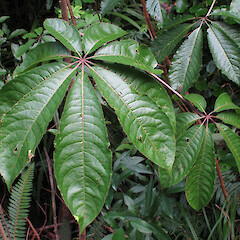Schefflera digitata
Common name
patatē, patē, seven-finger
Family
Araliaceae
Flora category
Vascular – Native
Endemic taxon
Yes
Endemic genus
No
Endemic family
No
Structural class
Trees & Shrubs - Dicotyledons
NVS code
The National Vegetation Survey (NVS) Databank is a physical archive and electronic databank containing records of over 94,000 vegetation survey plots - including data from over 19,000 permanent plots. NVS maintains a standard set of species code abbreviations that correspond to standard scientific plant names from the Ngä Tipu o Aotearoa - New Zealand Plants database.
SCHDIG
Chromosome number
2n = 24
Current conservation status
The conservation status of all known New Zealand vascular plant taxa at the rank of species and below were reassessed in 2017 using the New Zealand Threat Classification System (NZTCS) – more information about this can be found on the NZTCS website. This report includes a statistical summary and brief notes on changes since 2012 and replaces all previous NZTCS lists for vascular plants.
Please note, threat classifications are often suggested by authors when publications fall between NZTCS assessment periods – an interim threat classification status has not been assessed by the NZTCS panel.
- Conservation status of New Zealand indigenous vascular plants, 2017 . 2018. Peter J. de Lange, Jeremy R. Rolfe, John W. Barkla, Shannel P. Courtney, Paul D. Champion, Leon R. Perrie, Sarah M. Beadel, Kerry A. Ford, Ilse Breitwieser, Ines Schönberger, Rowan Hindmarsh-Walls, Peter B. Heenan and Kate Ladley. Department of Conservation. Source: NZTCS and licensed by DOC for reuse under the Creative Commons Attribution 4.0 International licence.
2017 | Not Threatened
Previous conservation statuses
2012 | Not Threatened
2009 | Not Threatened
2004 | Not Threatened
Brief description
Small bushy tree with (usually) 7 thin finely-toothed leaflets in a fan on a long stalk. Flowers in a diffuse cream spray
Distribution
Endemic. Widespread. North, South and Stewart Islands.
Habitat
Lowland to montane forest (sealevel to 1000 m a.s.l.).
Wetland plant indicator status rating
Information derived from the revised national wetland plant list prepared to assist councils in delineating and monitoring wetlands (Clarkson et al., 2021 Manaaki Whenua – Landcare Research Contract Report LC3975 for Hawke’s Bay Regional Council). The national plant list categorises plants by the extent to which they are found in wetlands and not ‘drylands’. The indicator status ratings are OBL (obligate wetland), FACW (facultative wetland), FAC (facultative), FACU (facultative upland), and UPL (obligate upland). If you have suggestions for the Wetland Indicator Status Rating, please contact: [Enable JavaScript to view protected content]
FACU: Facultative Upland
Occasionally is a hydrophyte but usually occurs in uplands (non-wetlands).
Detailed description
Dioecious(?) small tree to 8 m. Trunk irregularly branched; bark greenish, finely ridged and with scattered prominent lenticels. Petioles terete, to 25 cm long, sheathing branchlet, reddish. Petiolules to 2 cm, reddish. Leaves alternate, palmate, with (3)-10 leaflets (us. 7), upper surface evenly green in adult, underside pale, shiny, purplish in juvenile. Terminal leaflet to 20 cm long; lateral leaflets decreasing in size; obovate-cuneate, tip acuminate to obtuse; margins sharply serrate in adult, irregularly lobed to pinnatifid in juvenile. Inflorescence a panicle, axillary (occ. cauline), branches many, spreading, to 35 cm; bracts and bactlets small. Umbels many, up to 10 flowers in each; peduncles subsessile to 10 mm long, pedicels shorter. Flowers greenish cream, c. 7 mm diam. Petals 5(-6), acute. Stamens 5, filaments c. = petals. Style branches 5 (or more), connate below forming an irregular disc. Fruit subglobose,c. 3.5 mm diam., fleshy, dark purple when ripe, containing (5-)7-10(-11) seeds. Seed 2-2.5 mm.
Similar taxa
Vegetatively often confused with Pseudopanax species, particularly five-finger (Pseudopanax arboreus). The leaflets of Pseudopanax species are thicker, smaller, and with larger teeth on the margin.
Flowering
February-March
Flower colours
Cream, Green
Fruiting
February-March
Etymology
schefflera: Named in honuor of Jacob Christian Scheffler, an 18th-century German botanist who wrote about Asarum (wild ginger).
digitata: Divided into fingers
Attribution
Fact sheet prepared by P.J. de Lange for NZPCN (1 June 2013)
NZPCN Fact Sheet citation
Please cite as: de Lange, P.J. (Year at time of access): Schefflera digitata Fact Sheet (content continuously updated). New Zealand Plant Conservation Network. https://www.nzpcn.org.nz/flora/species/schefflera-digitata/ (Date website was queried)






















